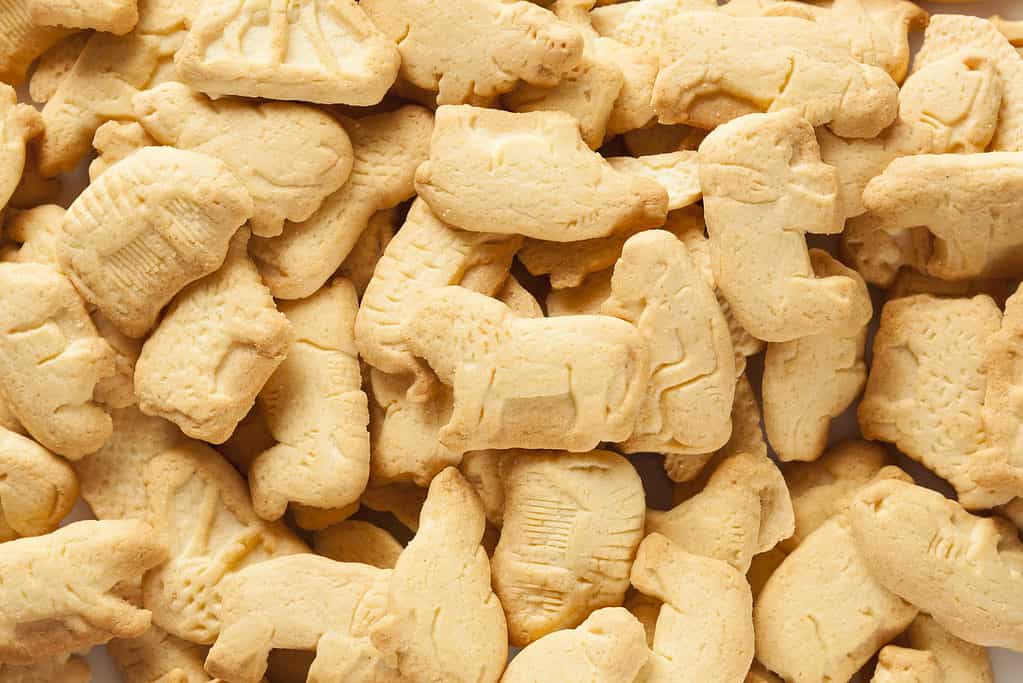As loving dog parents, we all enjoy sharing little moments—and sometimes little snacks—with our furry friends.
Yes, dogs can eat animal crackers in small amounts. They’re not toxic but contain sugar, salt, and additives, so offer them only occasionally. Always choose plain, unsweetened crackers and avoid overfeeding your dog.
In this article, we’ll explore whether animal crackers are safe, what risks they carry, and the best ways to treat your dog safely and responsibly.
Animal crackers are small, animal-shaped cookies loved by both children and adults. They are usually made from flour, sugar, oil, and flavorings like vanilla or honey. Their light crunch and nostalgic taste make them a pantry staple in many homes.
The story of animal crackers dates back to the late 1800s. They were first made in the United States by the Stauffer Biscuit Company, inspired by European animal-shaped cookies.
Over time, brands like Barnum’s brought them into colorful boxes shaped like circus train cars, adding fun and excitement to the treat.
Today, they come in many varieties—plain, chocolate, and frosted—but their basic recipe remains the same: sweet, crunchy, and made for humans.

Animal crackers are primarily composed of refined flour, sugar, oil, leavening agents, and artificial flavorings. While these ingredients make them tasty, they lack the nutrients dogs truly need.
A typical serving (about 8–10 crackers) includes:
- Calories: 120–150
- Sugar: 7–10g
- Fat: 3–5g
- Protein: 2g
- Fiber: 1g
For humans, that’s a light snack. For dogs, however, it can add unnecessary calories and sugars that contribute to long-term health issues.
Also Read: Is Lavender Safe For Dogs: The Truth Every Owner Should Know
- Sugar: Dogs don’t process sugar like humans. Too much leads to obesity, dental problems, and possibly diabetes.
- Salt: Even moderate salt can cause dehydration or kidney strain in dogs.
- Flour: Most animal crackers contain wheat flour, which may trigger allergies in some dogs.
- Artificial Additives: Preservatives, colors, or flavorings can irritate sensitive digestive systems.
- Fats & Oils: Some brands use hydrogenated oils, which are unhealthy for both humans and dogs.
Eating too many animal crackers can easily lead to weight gain and obesity. Dogs need nutrient-dense food, not empty calories. Over time, this can cause joint pain, heart strain, and reduced energy.
Dogs allergic to wheat, gluten, or dairy may experience itchy skin, ear infections, or upset stomachs. Even a small portion can trigger symptoms if your dog is sensitive.
Because animal crackers are dry and crunchy, smaller dogs may struggle to chew them properly. Breaking them into smaller pieces can reduce this risk, but always supervise your dog while eating.
Regularly feeding sugary treats like animal crackers may contribute to:
- Dental plaque and gum disease
- Insulin resistance and diabetes
- Nutritional imbalances due to excessive snacks
- Lower immune function over time
While not nutritionally valuable, animal crackers aren’t entirely harmful in very small amounts. Some benefits include:
- Bonding Moments: Sharing a small treat can build trust and joy between you and your pet.
- Low Toxicity: Most animal crackers don’t contain chocolate, xylitol, or raisins—common toxins for dogs.
- Emergency Snack: If you’re out of dog treats, one or two plain animal crackers won’t hurt your pup.
Still, they should be viewed as an occasional treat—not a dietary supplement.

If you occasionally want to share, follow these safe guidelines:
- Limit Quantity: Keep treats under 10% of daily calories. For most dogs, that’s one or two crackers max.
- Check Ingredients: Avoid brands with chocolate, xylitol, raisins, or artificial sweeteners.
- Choose Plain Options: Plain or unsalted crackers are best—no frosting or added sugar.
- Break into Small Pieces: Prevent choking, especially for small breeds or puppies.
- Observe After Feeding: If your dog shows any signs of discomfort—vomiting, itching, or diarrhea—stop immediately and call your vet.
Must Read: Can Dogs Eat Taro? – Don’t Miss This Expert Advice!
Usually, no—a few animal crackers won’t make your dog sick. However, overeating can lead to:
- Stomach upset (vomiting, diarrhea)
- Tiredness or dehydration from high sugar and salt
- Allergic reactions in sensitive dogs
If your dog accidentally eats a handful, watch them closely for symptoms. Offer plenty of water and contact your veterinarian if any concerning signs appear.
Veterinarians generally agree: Animal crackers are not toxic but not beneficial either. They should be reserved for rare occasions.
If your dog is healthy, free from allergies, and at a normal weight, giving one or two plain crackers occasionally is safe. Avoid if your dog has diabetes, obesity, or food allergies.
One small cracker equals about 10–15 calories. For a small dog, that’s already 5–10% of their daily allowance. More than 2–3 crackers at a time could contribute to unhealthy calorie intake.
If you want to offer safer, healthier snacks, vets recommend:
- Fresh Fruits: Apples (no seeds), bananas, blueberries, watermelon.
- Vegetables: Carrot sticks, cucumber slices, green beans.
- Dog-Specific Treats: Look for options labeled “low-calorie” or “vet-approved.”
- Homemade Dog Biscuits: Made with oat flour, peanut butter (xylitol-free), and pumpkin puree.
These options provide nutrients, fiber, and taste—without the sugar overload.
Offer a tiny piece first to test your dog’s tolerance. Watch for digestive or allergic reactions before giving more.
After the first bite, keep an eye out for:
- Itching or skin redness
- Vomiting or diarrhea
- Restlessness or unusual behavior
If everything seems fine, you can occasionally include a cracker as a special reward.
If your dog shows no sensitivity, you may give one small cracker once or twice a week. Always stick to moderation.
Substitute animal crackers with healthier snacks like baby carrots, apple slices, or dog biscuits made from natural ingredients. These treats satisfy cravings while supporting health.
Your dog’s main meals should come from high-quality dog food that meets all nutritional needs. Treats—including animal crackers—should complement, not replace, a balanced diet.
Read Out: Can Dogs Drink Gatorade? Owner’s Guide: Safe or Not!
No, dogs shouldn’t eat animal crackers every day. These snacks contain sugar, salt, and flour that can upset your dog’s stomach or cause weight gain. Give them only once in a while as a tiny treat.

Most animal crackers do not contain xylitol, but it’s always smart to check the label. Xylitol is toxic to dogs and can cause serious health issues. Always avoid giving any snack unless you’re sure it’s xylitol-free.
You can make dog-friendly animal crackers using whole wheat flour, peanut butter, and water. Mix the dough, cut into shapes, and bake until crisp. They’re healthy, homemade, and safe for your furry friend to enjoy!
Dogs can eat a few Stauffer’s animal crackers, but not too often. They contain sugar and flavoring that aren’t great for dogs. One or two pieces occasionally are fine, but they shouldn’t replace proper dog treats.
Ritz crackers aren’t safe for dogs to eat regularly. They have high salt and fat, which can harm your dog’s health. If your pup eats one accidentally, it’s okay—but don’t make it a habit.
No, salted crackers aren’t healthy for dogs. Too much salt can make them thirsty and even cause sodium poisoning in large amounts. Always choose plain, unsalted crackers if you want to share a small bite.
Cats can eat a tiny piece of animal cracker, but it’s not healthy for them. Cats need meat-based foods, not sweet or starchy snacks. It’s best to give them treats made especially for cats.
If your dog ate many crackers, watch for vomiting or diarrhea. Offer water and call your vet if they seem sick or act strange.
Yes, dogs can eat a few animal crackers safely. Avoid giving too many since they contain sugar and flour that aren’t great for dogs.
Goldfish crackers aren’t toxic but aren’t healthy either. They contain salt and cheese powder that can upset your dog’s stomach if eaten often.
Dogs can eat plain, unsalted crackers in small pieces. Avoid flavored or buttery ones since they often contain ingredients harmful to dogs.
Most animal crackers don’t have xylitol, but always check the ingredients. Xylitol is very dangerous to dogs, even in tiny amounts.
No, dogs shouldn’t eat iced animal crackers. The icing contains sugar and artificial ingredients that can cause stomach upset or weight gain.
Yes, many pet brands make dog-friendly animal crackers. They’re made with safe ingredients like oats, pumpkin, or peanut butter for healthy snacking.
Animal crackers have too much sugar for dogs. They’re okay as rare treats but shouldn’t replace healthy, low-sugar dog snacks.
Even if your dog loves them, animal crackers aren’t good treat alternatives. Offer dog-safe treats instead for better nutrition and long-term health.
Animal crackers may look cute and harmless, but they’re made for humans—not dogs. While one or two plain, unsweetened crackers occasionally won’t harm your furry friend, they shouldn’t become a regular part of your dog’s diet. These treats contain sugar, salt, and refined flour that add empty calories and can lead to weight gain, dental problems, or stomach upset over time.
If you want to share a snack, it’s always best to choose vet-approved dog treats or natural options like carrots, apples, or pumpkin biscuits. Your dog’s health and happiness depend on balanced nutrition, not sugary snacks.
In short—yes, dogs can eat animal crackers, but only in moderation and with care. Always check ingredients, keep portions tiny, and prioritize wholesome, nutrient-rich foods for a longer, healthier, tail-wagging life.
